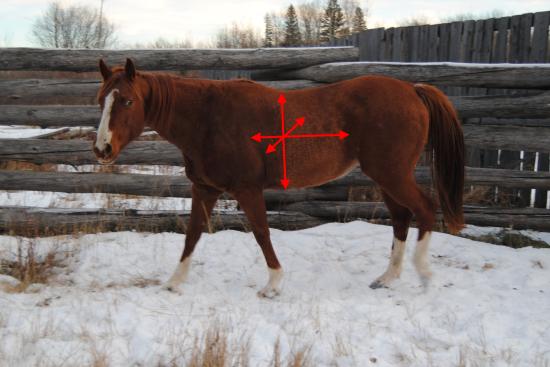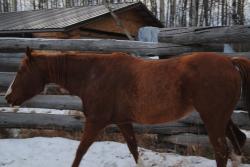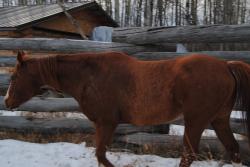Movement of the rib cage
We are no longer building saddle trees, but we have two videos about how Western saddles fit horses available on our westernsaddlefit.com website.

It is pretty well known in the cowboy world that you don't want your cinch, latigos and billets to be all synthetic material. You want at least something (preferably all) to be of natural materials so there is some give, a little bit of stretch so your horse can expand his chest as he breathes. When you consider the anatomy of the equine rib cage and realize how relatively rigid it is, it isn't overly surprising that that there isn't a whole lot of change in total circumference, which is what allows a cinch to hold the saddle on at all. (If there was a lot of change with every breath, either the cinch would hang loose part of the time or it would obstruct his breathing with every breath.) What is interesting is research that shows that the total change in circumference of the chest where the cinch goes is less than an inch, even when the horse is galloping. (1)
Circumference, length and diameter in different directions
However, total circumference isn't the only thing that matters. This is because as the chest gets wider side to side, it gets shorter top to bottom and vice versa. (2) Considering that the ribs under the cinch are connected both top and bottom, this makes sense. But it is also important to know that the rib cage changes shape differently side to side as the horse moves, and these changes vary depending on the gait.
 |
 |
As you can see in the pictures above, the rib cage lengthens as the legs are stretched apart and shortens when they are together in a Vee. (It is fun to click back and forth between these two pictures in our picture program. You can really see the difference as she moves then!) This happens because the ribs themselves get closer together and farther apart as the horse's legs move. In the same way, the horse's chest rounds out, first on one side and then on the other. In a study done on rib cage shape and movement, they discovered that the radius from the center of the horse to the outside of the rib cage can increase over three inches at certain phases of the stride compared to the standing horse. (They think this is because the muscles that pull the body forward toward over the planted front leg attach on the ribs, so that pulls the ribs forward and, because they are curved, out and away from the midline, it moves out in the same way a bucket handle moves away from the rim of the bucket as you lift it. (1), (2) ) So there really is good reason to use natural material cinches and latigos that have some stretch to them!
Cinches, cinching and the rib cage
A study was done in 1999 to see how the tightness of the girth affected race horses. (3) They had to have them tight enough that the saddles didn't slip. 5 kg which is 11 lbs tension was their loosest. From there up, the tighter the girth, the poorer the performance, until they got to 15 kg or 33 lbs tension where it stabilized. Beyond that, a tighter girth didn't make performance worse.
So what? How is this practical?
Unless you are saddling race horses, you may think it isn't. However, it does tell us that a tight cinch affects the horse's stamina, probably due to his ability to breathe deeply. Even if you aren't going for high speed or other performance events, it still is affecting your horse. If your saddle slips around, you are more apt to tighten the cinch to hold it in place. A good fitting saddle, like two spoons nestled together, doesn't move around compared to the horse. So you can ride with a looser cinch, allowing your horse to work for longer without the same level of fatigue.
Some interesting results
Study # 1 also tested abdominal circumference (at the level of the 16th and 17th rib which is just back of where a back cinch would go) as well as chest circumference (around about ribs 7 and 8, which is about where a front cinch would usually sit) in relation to breathing. They found that at any gait, the average circumference of the chest was greater than at rest (even a very small amount). But the average circumference around the abdomen was always less than at rest. Even when walking, the horse contracted his abdominal muscles enough to "suck in his gut" as it were. This explains why the back cinch is loose even if it is snugged up before you move. It also emphasizes the need to snug it at rest so it doesn't dangle too far down, ready to catch a branch or a foot, when the horse is working.
They also found that at the walk and trot, the chest and abdomen both expanded with inspiration. That makes sense - as you breathe in, your chest expands. Breath out, it collapses down a bit. But what was interesting was that at the lope or gallop, as the chest expanded, the circumference of the abdomen decreased, and vice versa. They were totally out of phase with each other. And what was even more interesting was that this did not correspond to inspiration and expiration. In fact, the chest got smaller as the horse started to breath in (while the abdomen got bigger), but it started to increase in circumference about the middle of inspiration (while the abdomen got smaller). Then, the chest continued to expand as the horse breathed out! After that, it decreased in size as he breathed in again. There are a number of ideas as to specifically why this happens, but it primarily has to do with the length of the chest cavity (the diaphragm is the main component in increasing chest capacity in the horse at all gaits anyway). The bottom line is that at the lope and gallop, the horse breathes in phase with his stride, so it is the leg movements which increase trunk length that affect breathing rather than chest movement.
Ultimately, the take home message from all this - sometimes what happens in real life doesn't fit with what we expect to happen due to the way things look like they should perform or the way they perform in other species or other situations. And a lot of what is currently stated as fact about saddle fit comes from what people expect to happen - not real knowledge about what really does happen. Just because it looks like it should be this way doesn't necessarily make it so!
And this is very true when it comes to muscles - when they are active and what they actually do. So... on to muscles next!
(1) Movements of thoracic and abdominal compartments during ventilation at rest and during exercise, DJ Marlin, RC Schroter, PMM Cashman, CM Deaton, DC Poole, CA Kindig, P McDonough, HH Erickson, Equine Veterinary Journal Supplement 34 (2002) 384-390
(2) Transverse and dorso-ventral changes in thoracic dimension during equine locomotion, CT Thorpe, DJ Marlin, SH Franklin, GR Colbourne, The Veterinary Journal 179 (2009) 370-377
(3) Influence of girth strap tensions on athletic performance of racehorses, JR Bowers, RF Slocombe, Equine Veterinary Journal Supplement 30 (1999) 52 - 56
